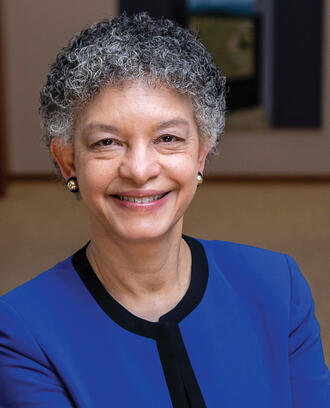Credit: Rob Dobi
As experts strive to predict how COVID-19 will continue to impact the economy, are there lessons to be learned in looking back to the 2008 financial crisis?
Yes and no, said a group of MIT Sloan economists. In a recent webinar, hosted by the MIT Golub Center for Finance and Policy, they cautioned there are important differences to keep in mind.
“We don't have a financial crisis right now — we have a public health crisis,” said an MIT Sloan professor of finance. “That's had some very significant implications for financial markets . . . and over the course of the next few weeks to months, we're actually going to see potentially even more disruption.”
Speakers offered up a variety of potential economic solutions but said they are contingent on more effectively containing the coronavirus, or even better, finding a permanent solution.
“We as a nation are not generating output and income and profits right now, and there's no way for the financial and economic policies of the government to get back that output that we're losing,” said an MIT Sloan professor of finance. “We’ve lost a bunch of wealth, a bunch of income, and the longer the health crisis continues, the more wealth will be lost.”
The economists unpacked many of these implications and offered suggestions on what the U.S. government can do to help. Some of their ideas:
Give small businesses more flexibility
With wages and rent to pay, cash-constrained small businesses have been among the hardest hit by the coronavirus, and more should be done to help them, the economists agreed.
The paycheck protection program (PPP), which is the part of the CARES Act, allowed small businesses to apply for low-interest loans through their banks to cover some of their expenses, such as paying their workers’ wages, but the efficacy of these and other credit programs isn’t yet clear, saidfaculty director of the Golub Center.
“For many businesses right now, the problem is not so much access to credit as it is solvency. It remains to be seen whether the programs will be effective at averting job losses and preventing bankruptcies,” said Lucas, a distinguished professor of finance at MIT Sloan. “At this point, it's still highly uncertain what the take-up rates will be, whether the money will reach those who really need it, and what the loss rates will be in the end.”
an MIT Sloan professor of finance and entrepreneurship, pointed out the PPP actually forces the owners of small businesses to maintain their cost structure at pre-COVID-19 levels in order to qualify for loan forgiveness. What’s needed, Schoar said, are additional provisions that would allow small businesses to renegotiate with their stakeholders.
In addition, the government should make sure that it’s targeting funding to the industries and regions most in need and to businesses that are cash-constrained and don’t have other access to funds — not to companies that don’t need it.
That sentiment was echoed by MIT Sloan Distinguished Professor of Finance who said that there is “really no reason to bail out big firms” that can safely reorganize under Chapter 11.
“One of the reasons we end up bailing out entities that we don't really want to is because they get mixed up with entities that we do want to take care of,” Merton said, adding that now is the time to “develop and invest more in more efficient distribution systems” for any further aid.
Provide more liquidity to financial institutions
Markets would rise 5% – 15% the first time the FDA proves efficacy for a COVID-19 vaccine, predicted MIT Sloan Professor Andrew Lo.
Markets have been on a rollercoaster the last several months, and Lo forecast even more disruption in the next few weeks to months. “The volatility of volatility has been extraordinarily high,” he said. “Right now it's very difficult for both individuals and institutions to know what to do with their financial assets.”
Some events with the potential to impact the market are predictable to a certain extent. For example, Lo predicted that markets would drop by 10% to 20% if Dr. Anthony Fauci — the nation’s top infectious disease expert and a member of the White House’s coronavirus task force — were to lose his job. Conversely, markets would rise by 5% to 15% the first time the Food and Drug Administration developed and proved efficacy for the first vaccine for COVID-19, Lo said.
Other developments remain a black box for now. But “there are a number of things that financial policy makers or regulators can do to make it easier for us to deal with this volatility,” Lo said. One idea: provide liquidity to financial institutions so that they, in turn, can provide liquidity to consumers and those businesses that need it.
His advice for navigating the current uncertainty? “Unless you need liquidity in the short term, my perspective is to leave the money in [the market] and expect that there's going to be improvements once we deal with the public health crisis,” he said.
Limit penalties for retirement withdrawals
Merton said that the CARES Act “took a step in the right direction” by limiting penalties and other barriers that stopped people from accessing funds in their 401(k) plans in order to cover their current expenses. But the government could do more, he said.
One possibility is giving people the option to give up some of their defined benefit rights so that they can receive cash from a pension fund or employer plan. “Not for everyone in every situation, but the point is making these available,” Merton said.
Given that pension funds and 401(k) plans are both assets that belong to the individual, Merton said that people should have broader access to their savings in times of crisis to keep them on track for eventual retirement and to help ensure that there’s a “system in place robust enough to deal with many different people’s lifestyles and needs.”
First and foremost, address the health crisis
All the economists agreed that it will be impossible to fix the U.S. economy until the virus is under control and it’s safe for people to return to work.
Parker noted that one unique challenge with COVID-19 is that the virus affects the economy on both the supply and demand side, which greatly disrupts the supply chain. This means that the sooner people feel safe out in the world working and shopping, the more likely the economy can begin to recover.
“The policy target should be about getting people back to work as soon as possible, and that requires, I think, safety,” Parker said.



